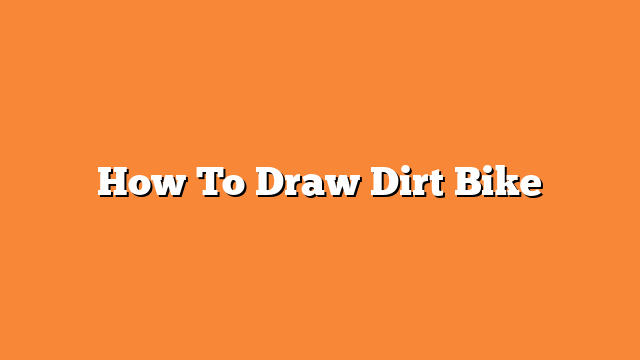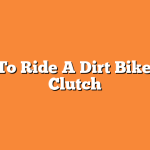Are you a fan of dirt bikes and want to learn how to draw them?
With a little practice and patience, you can create a realistic and detailed drawing of your favorite bike.
In this article, we will guide you through the step-by-step process of drawing a dirt bike from scratch.
Before starting, gather all the necessary materials such as pencils, erasers, paper, rulers, and any other tools that can aid in your drawing process.
Once you have everything ready, it’s time to prepare yourself mentally for the task at hand.
Drawing a dirt bike requires attention to detail and precision; therefore, it is crucial to stay focused throughout the entire process.
Now that you’re geared up let’s dive into sketching out the basic shapes and outline of your dirt bike!
Table of Contents
- 1 Key Takeaways
- 2 Gathering Materials and Preparing to Draw
- 3 Sketching the Basic Shapes and Outline
- 4 Adding Details to the Frame and Wheels
- 5 Creating the Engine and Handlebars
- 6 Adding Finishing Touches for a Realistic Look
- 7 Frequently Asked Questions
- 7.1 How do I choose the right paper for drawing a dirt bike?
- 7.2 What are some common mistakes to avoid when drawing a dirt bike?
- 7.3 How do I create a sense of motion and speed in my dirt bike drawing?
- 7.4 Are there any specific techniques for shading and highlighting a dirt bike drawing?
- 7.5 How can I make my dirt bike drawing look more dynamic and exciting?
- 8 Conclusion
Key Takeaways
- Gathering necessary drawing materials is important, including a pencil with a hard lead, an eraser, and appropriately sized paper.
- Finding and studying a reference image of a dirt bike is crucial to understanding how the parts fit together and achieving a realistic look.
- Sketching basic shapes and refining them into a more detailed outline, while paying attention to details and proportions, is the key to a successful drawing.
- Adding details to the wheels, engine, and handlebars, as well as finishing touches such as logos and shadows, will bring the drawing to life and create a finished product ready for display.
Gathering Materials and Preparing to Draw
You’ll need to grab some paper, a pencil, and an eraser before you can start sketching out your dirt bike.
Make sure that the paper you choose is large enough to accommodate the full size of your dirt bike drawing.
Choose a pencil with a hard lead so that your lines will be crisp and clear.
An eraser is also essential for correcting any mistakes along the way.
Once you have all of your materials ready, it’s time to start preparing to draw.
Begin by finding a reference image of a dirt bike that you’d like to draw.
This could be from a magazine or online source.
Take some time to study the image closely, paying attention to its details such as the wheels, engine, handlebars, and exhaust system.
This will help you gain an understanding of how these parts fit together to create a realistic-looking dirt bike drawing.
Sketching the Basic Shapes and Outline
Gonna start by roughing out the fundamental shapes and outline of this two-wheeled beast.
Begin by sketching the shape of the dirt bike’s body, which consists of a long, narrow rectangle for the frame and two smaller rectangles for the front and back fenders.
The seat should be a small oval located near the middle of the frame.
Next, add in basic shapes for the wheels, handlebars, and engine.
The wheels are circles or ovals that sit on either end of the frame, while the handlebars are long thin rectangles that extend from just above the front wheel to where they meet with another set of smaller rectangles representing hand grips.
Finally, sketch in an elongated teardrop shape to represent the engine block at an angle on one side of your dirt bike drawing.
Once you have these basic shapes down, refine them into a more detailed outline using lighter lines.
This will help you make any necessary adjustments before committing to darker lines or shading later on.
Remember to keep your lines fluid and confident as you work towards creating a realistic representation of your dirt bike subject!
Adding Details to the Frame and Wheels
To add more intricacy to your sketch, start incorporating detailed lines and shapes into the frame and wheels of the dirt bike.
This will give your drawing a more realistic look, making it appear as if the dirt bike’s ready to take off on an adventure.
Here are some tips to help you add details to the frame and wheels:
- Start by adding curves and angles to the frame of the dirt bike.
This’ll make it look more dynamic and lifelike.
- Next, focus on adding detail to the wheels.
Draw spokes, tread patterns, and rims that are realistically sized in proportion to your dirt bike’s overall dimensions.
- Don’t forget about adding shocks or suspension systems for both front and back wheels, which are crucial components that support riders during rough terrains.
- Another key aspect is the exhaust pipe at the rear end of the engine block, which provides a way for gases to form during the combustion process out of the engine cylinder.
- Finally, add any additional detailing like seat shape or handlebars depending on your preferences.
Remember that adding details can be time-consuming, but taking your time results in a drawing with exceptional realism.
Keep practicing these techniques until you feel confident enough to tackle even more challenging aspects like shadows and highlights on different parts of your dirt bike sketch.
Creating the Engine and Handlebars
Now it’s time to craft the powerhouse of your two-wheeled machine and steer with precision by creating the engine and handlebars.
The engine is the heart of your dirt bike, so let’s start there.
Begin by drawing a rectangular box for the crankcase at the bottom of the frame.
Draw two cylinders on top of it, one slightly larger than the other, to represent the pistons.
Connect them with a curved line that will serve as the head.
Incorporate more details into your engine by adding fins on both sides of each cylinder to help dissipate heat and improve performance.
Add spark plugs, exhaust pipes, and carburetors for an authentic look.
For your handlebars, draw a straight line across the top tube of your frame where you want them to be located.
Then draw two lines perpendicular to that line extending up from either side of it.
These will be your handlebar risers.
Now add another straight line connecting these risers to create a base for your handlebars table.
| Handlebar | Description |
|---|---|
| Grips | Drawing grips can be tricky but try sketching out an oval shape with finger grooves on each end |
| Crossbar Pad | A small cylinder shaped object in between handlebars used for safety purposes |
| Throttle | A control device used by riders which increases/decreases speed |
| Brake Lever | Connected to brake cables/hoses which when pulled stops or slows down wheel rotation |
| Clutch Lever | Similar in function to brake levers but is connected instead to clutch cables/hoses which disengages power transmission when pulled |
There are various types of handles depending on what type of riding you plan on doing (motocross vs off-road).
Ensure they fit comfortably within reach while sitting down and standing up positions as well as being visually pleasing aesthetically speaking!
Lastly make sure all proportions are correct before moving on to your next step!
Adding Finishing Touches for a Realistic Look
It’s time to add those final details that will bring your engine and handlebars to life and make them look like the real deal!
First, focus on the wheels.
Draw in the spokes, making sure they’re evenly spaced and symmetrically aligned.
Add some texture to the tires by drawing small lines around the circumference of each one.
Don’t forget about the brake discs!
These should be visible through the spokes and will give your dirt bike a more realistic appearance.
Next, move on to the exhaust pipe.
This is an important detail as it adds character to your dirt bike while also providing functionality.
Draw in all of its intricate pieces, including any brackets or connections, and consider adding a slight metallic sheen for added effect.
Finally, add any logos or branding decals that would appear on a real dirt bike.
Pay attention to placement and size so that they look authentic but not overwhelming.
With these finishing touches complete, step back and admire your newly drawn dirt bike – it’s ready for action!
Frequently Asked Questions
How do I choose the right paper for drawing a dirt bike?
To choose the right paper for drawing a dirt bike, consider the medium you’ll be using and your desired level of detail.
A heavier-weight paper with a smooth texture is ideal for pencil and ink drawings, while a toothy surface works well for pastels or charcoal.
What are some common mistakes to avoid when drawing a dirt bike?
Avoid common mistakes when drawing a dirt bike by ensuring correct proportions, perspective, and details.
For example, don’t forget to accurately depict the shape of the seat or the placement of the exhaust pipes.
How do I create a sense of motion and speed in my dirt bike drawing?
To create a sense of motion and speed in your dirt bike drawing, use dynamic lines to show movement, add shading to indicate depth and dimension, and incorporate elements like dust trails or windblown hair.
Are there any specific techniques for shading and highlighting a dirt bike drawing?
To add depth and detail to your dirt bike drawing, use shading techniques such as cross-hatching, blending, and stippling.
Use a light source to create highlights on reflective surfaces like the exhaust pipe or handlebars.
Practice different textures and materials to perfect your technique.
How can I make my dirt bike drawing look more dynamic and exciting?
“Rev up the excitement in your dirt bike drawing by adding dynamic elements such as motion blur, dust clouds, and a rider leaning into a turn.
Use bold lines and contrasting colors to bring your creation to life.”
Conclusion
Congratulations!
You’ve successfully completed your dirt bike drawing.
You should be proud of yourself for taking on this challenge and turning it into a masterpiece.
But wait, there’s one more thing you can do to take your drawing to the next level.
Imagine adding color and shading to truly bring your dirt bike to life.
By using various tones and textures, you can create depth and dimension that will make your artwork stand out.
So go ahead, grab your colored pencils or paint set and experiment with different techniques until you achieve the desired effect.
Don’t be afraid to push yourself outside of your comfort zone and try new things.
Who knows, you may discover a hidden talent or passion for art that you never knew existed!
Keep practicing, keep improving, and most importantly, have fun creating amazing works of art like this dirt bike drawing.







